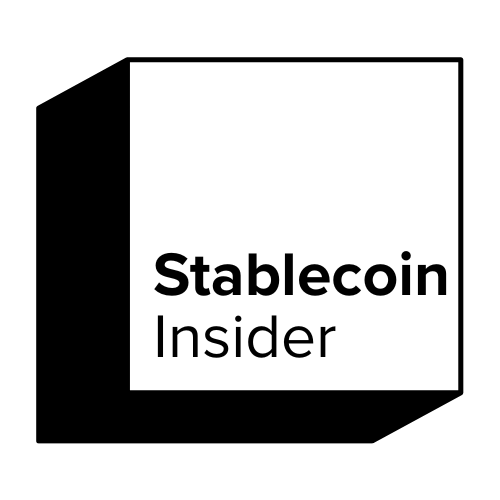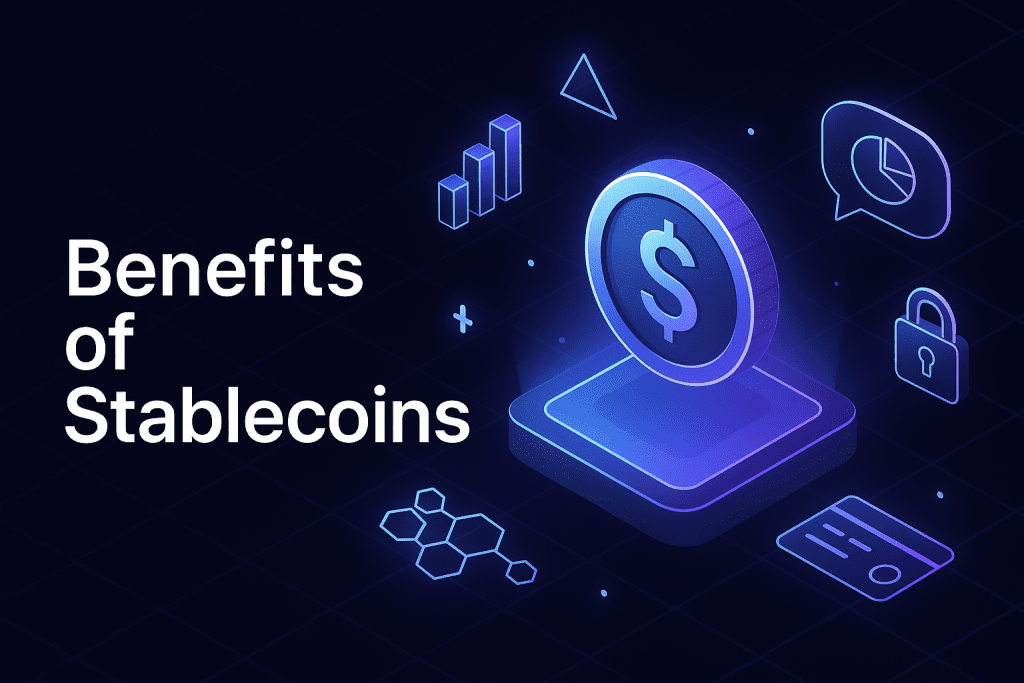Stablecoins have emerged as one of the most significant innovations in the cryptocurrency space, combining the benefits of digital assets with the stability of traditional fiat currencies.
As their adoption accelerates in 2025 across financial services, international payments, DeFi, and even payroll systems, understanding the unique advantages they offer is critical for individuals, businesses, and institutions.
In this article, we’ll break down the real-world benefits of stablecoins and explore why they’re becoming essential in the evolving global financial system.
Key Takeaways:
- Stablecoins are pegged to fiat currencies like the USD, offering price stability.
- They enable fast, low-cost, borderless transactions.
- Stablecoins are increasingly used in DeFi, payroll, remittances, and savings.
- They bridge the gap between traditional finance and the crypto economy.
What Are Stablecoins?
Stablecoins are digital assets designed to maintain a stable value by being pegged to a reserve asset like the US dollar or gold. Unlike traditional cryptocurrencies, their value does not fluctuate wildly, making them more reliable for everyday use. They serve as a foundational layer for many blockchain applications.
Types of Stablecoins
There are three main types of stablecoins, each with its own mechanism for maintaining price stability:
- Fiat-collateralized: These are backed 1:1 by traditional currency reserves. USDC and USDT fall into this category.
- Crypto-collateralized: Backed by other cryptocurrencies, often over-collateralized to account for volatility. DAI is a key example.
- Algorithmic: These rely on code-based supply-and-demand mechanisms. TerraUSD (UST), which failed in 2022, was a well-known example.
Each type has different use cases and risk profiles, with fiat-backed coins being the most trusted.
Related: What is a Stablecoin?
Benefits of Stablecoins
Price Stability in a Volatile Market
Volatility is a known issue in the cryptocurrency market, which can make using crypto for everyday transactions difficult. Stablecoins solve this by offering a digital asset that maintains a consistent value over time.
This makes them ideal for saving, investing, and transacting without fear of value fluctuation. By pegging their value to stable assets like fiat currencies or commodity-backed reserves, stablecoins provide a reliable alternative to traditional cryptocurrencies.
This stability not only facilitates smoother transactions but also enhances the overall usability of digital currencies in real-world scenarios. As a result, stablecoins are increasingly becoming a cornerstone in the evolving landscape of digital finance.
Benefits of Price Stability
- Investor refuge: During bear markets, stablecoins let traders preserve capital.
- Predictable pricing: Merchants and service providers can price goods in stablecoins without revaluing constantly.
- User trust: Consistent value builds user confidence, encouraging broader adoption.
- Cross-border transactions: Stablecoins enable seamless international payments without the risk of exchange rate volatility.
Faster, Cheaper Transactions
Sending money internationally via banks can be slow and costly due to intermediary fees, exchange rates, and delays. Stablecoins allow peer-to-peer transfers that settle in real time. This efficiency is transforming everything from freelance payments to international business operations.
By eliminating the need for traditional banking intermediaries, stablecoins reduce transaction costs significantly, making them an attractive option for both individuals and businesses. Additionally, the transparency of blockchain technology ensures that all transactions are secure and easily traceable.
As more people and companies recognize these benefits, the adoption of stablecoins for cross-border transactions is expected to grow rapidly.
Key Advantages
- Speed: Transfers take seconds or minutes, not days.
- Low fees: Minimal network fees versus traditional remittance services.
- Availability: Transactions can happen 24/7/365 without bank approval.
- Security: Blockchain technology provides a secure and transparent transaction environment.
Financial Inclusion and Access
A large portion of the global population remains outside the formal banking system. Stablecoins and blockchain wallets can provide financial tools without the need for a bank account. This opens access to savings, credit, and payments for people in underbanked or inflation-prone regions.
Real-World Impact
- Latin America: In countries like Argentina, stablecoins hedge against hyperinflation.
- Africa: Mobile apps like Fonbnk use stablecoins to pay users with no formal bank accounts.
- Asia: In places with unstable banking, stablecoins offer alternative economic freedom.
Use in DeFi (Decentralized Finance)
Stablecoins are the lifeblood of DeFi, which aims to create a decentralized financial system. They are used as base currencies in trading pairs, as collateral for loans, and to earn yields.
Their price stability allows DeFi users to operate with predictability and lower risk. By providing a stable medium of exchange, stablecoins facilitate seamless transactions within DeFi platforms, enhancing user experience and trust.
Moreover, they enable users to hedge against market volatility, ensuring that their investments and returns remain stable. As DeFi continues to evolve, the role of stablecoins is expected to expand, driving innovation and accessibility in the financial sector.
DeFi Utility
- Collateral: Users deposit stablecoins to borrow volatile assets.
- Liquidity pools: Help balance trading pairs and earn fees.
- Stability: Reduce volatility across DeFi applications and protocols.
- Yield farming: Users can stake stablecoins to earn interest or rewards, maximizing their returns.
Crypto Payroll and Business Payments
Businesses operating globally can benefit from stablecoins by simplifying payroll for remote and international teams. Payments are quicker, cheaper, and more transparent. Crypto-native companies are already leveraging stablecoins to streamline operations and reduce friction.
Business Benefits
- Borderless payroll: Pay contractors in any country in seconds.
- No currency conversion: Reduce losses due to FX fees.
- Traceable payments: On-chain records simplify accounting and compliance.
Cross-Border Remittances
Sending money across borders is one of the most expensive financial transactions in the world. Stablecoins drastically lower the cost while increasing the speed of delivery. Families in developing countries can receive remittances in minutes, often at 10% of the traditional cost.
Compared to Traditional Remittances
- Costs: Remittance via Western Union or MoneyGram can be 6-10%, versus 0.5-1% for stablecoins.
- Speed: Same-day or even real-time delivery.
- Accessibility: Recipients only need a smartphone and internet connection.
Savings, Staking, and Inflation Protection
Stablecoins aren’t just for spending, they’re also for saving. In DeFi and centralized platforms, users can earn yield by staking or lending stablecoins. In countries with inflation, converting local currency to stablecoins protects purchasing power.
This ability to preserve value makes stablecoins an attractive option for individuals seeking to safeguard their wealth against economic instability. Furthermore, stablecoins offer a flexible and accessible way to participate in the global financial system, even for those without access to traditional banking services.
As more people recognize these benefits, the adoption of stablecoins for savings and investment purposes is likely to increase.
Opportunities for Savers
- DeFi yields: Many platforms offer 4–12% APY on stablecoins.
- Low volatility: Safer than investing in volatile crypto assets.
- Mobile access: Users can save and earn from anywhere with an internet connection.
- Inflation hedge: Protects against currency devaluation in unstable economies.
Institutional Adoption and Regulation
Banks, fintechs, and governments are increasingly exploring or integrating stablecoins. Regulation is catching up, providing legal frameworks to ensure safety and transparency. This legitimization could lead to mass adoption and the integration of stablecoins into the global financial system.
Regulatory Landscape
- U.S.: Multiple proposals aim to regulate reserve backing and issuer audits.
- EU: The Markets in Crypto-Assets (MiCA) framework provides regulatory clarity.
- Asia: Countries like Japan and Singapore are piloting stablecoin-friendly laws.
Challenges and Risks
Despite their benefits, stablecoins aren’t without risks. Some are over-reliant on central issuers, creating counterparty risk. Others, especially algorithmic stablecoins, can collapse under market stress, as we saw with TerraUSD.
Key Risks
- Centralization: Many stablecoins are issued by single entities, increasing systemic risk.
- Transparency: Not all issuers provide regular audits or clarity about reserves.
- Regulatory grey areas: Confusion around jurisdiction and oversight can hinder growth.
The Future of Stablecoins
Stablecoins are evolving fast. We can expect further integration with banks, improved regulatory clarity, and more real-world use cases. Their utility in tokenized assets, real-world assets (RWAs), and programmable payments will expand as the financial ecosystem digitizes.
Trends to Watch
- Bank-issued stablecoins: JPMorgan’s JPM Coin is just the beginning.
- RWAs: Tokenization of bonds, real estate, and commodities backed by stablecoins.
- Cross-chain use: Layer-2s and bridges will enhance interoperability and efficiency.
Conclusion
Stablecoins are no longer niche, they’re foundational. Whether you’re a crypto investor, a business owner, or someone simply looking to protect your savings, the benefits of stablecoins are clear. Their combination of stability, speed, accessibility, and utility is reshaping how the world thinks about money.
Read Next:
FAQs
1. Are stablecoins safe to use?
Generally, yes—especially fiat-collateralized ones like USDC that are regularly audited. However, it’s important to research the issuer and understand how the coin is backed.
2. What is the difference between USDC and USDT?
USDC is issued by Circle and is known for greater transparency and regulation. USDT, issued by Tether, has faced more scrutiny but remains the most widely used stablecoin.
3. Can I earn interest on stablecoins?
Yes, through DeFi platforms, crypto savings accounts, and staking services. Rates vary based on market demand and platform risk.
4. How do I buy and store stablecoins?
You can buy stablecoins on most crypto exchanges and store them in digital wallets, including mobile apps, hardware wallets, or browser extensions.
5. Are stablecoins legal in my country?
Regulations vary by country. Some jurisdictions like the U.S., EU, and Singapore are creating frameworks for legal use, while others have restrictions.
6. What are the risks of holding stablecoins long-term?
Risks include regulatory changes, issuer insolvency, or depegging. Diversifying holdings and staying informed is key.
7. Can I use stablecoins for everyday purchases?
Yes, some merchants accept stablecoins directly. Others may use crypto debit cards or convert stablecoins at the point of sale.

